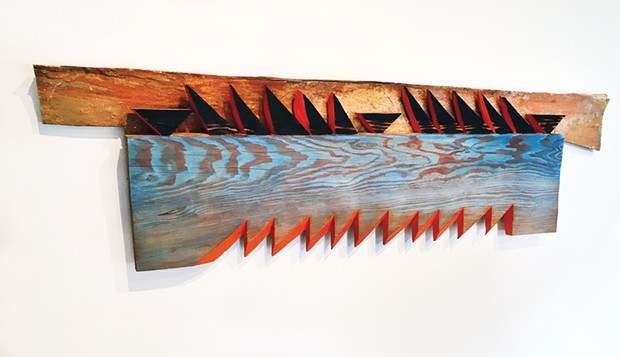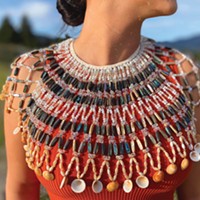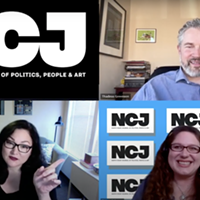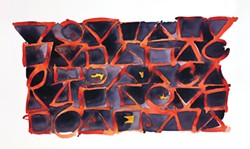Full Circle Journey
Robert Benson's Tintah: Amongst the Trails at the Goudi'ni Native American Arts Gallery
By L.L. Kessner
Courtesy of Goudi'ni Native American Arts Gallery
"Burning Along the River," by Robert Benson.
[
{
"name": "Top Stories Video Pair",
"insertPoint": "7",
"component": "17087298",
"parentWrapperClass": "fdn-ads-inline-content-block",
"requiredCountToDisplay": "1"
}
]
"I will never lose the sense that I'm not separate," says Robert Benson. In an Oct. 10 talk about his exhibition at Cal Poly Humboldt's Goudi'ni Gallery, he described his intimate relationship with the environment and all its elements, explaining how his relationship to the land, his sense of un-separateness informs his art.
Benson's exhibition Tintah includes works in wood and works on paper, presenting layers of interwoven relationships between categories that appear at first glance to be separate. Tensions between curved and angular lines are central to the show's aesthetic. Carved into wood and painted on paper, structural patterns interact with limitless variation. Benson says that the curved and angular lines in his art operate "like jazz." Poetically, he relates the interplay between the melody and percussive lines in music to the interplay between the organic and geometric structures in his work. The visual rhythm of the show is undeniable.
In the Hupa language, the word tintah means "amongst the trails." Benson relates that while formulating the show, CPH Gallery Director Brittany Britton told him, "I want a forest of verticals in this room." That is exactly what viewers get in the Goudi'ni Gallery: a trail through the space, which leads them around and through 6- to 8-foot-tall standing wood pillars each covered in relaxed linear designs, and past many waypoints of mounted watercolor paintings depicting rows of related designs in vibrant colors.
Benson's tall, freestanding pillars maintain a two-dimensional quality that relates to the paintings. Each sculpture has four flat sides that are carved as raised planes. The designs exist in bas-relief on the surfaces. The structures seem almost as though they were built by folding. In these and in Benson's other sculptures, it appears that the process of carving reveals a hidden geometry within the organic forms. His geometric designs are all mathematically imperfect. They look slightly melted, presenting a synthesis of the geometric and organic. In all the works in the show, micro geometry appears to build into an organic macro structure.
Benson states that the only language in his work is visual language. The linear arrangement of his repetitive marks, particularly in the paintings, though, does call writing to mind. The discrete geometric strokes invoke a symbolic recognition, as if they belong to a system of signs, some fundamental language just beyond knowledge.
Benson talks about a visual language of geometry, saying he is influenced by woven geometric designs in baskets, leather purses and regalia. However, in making contemporary art for a fine art context, he doesn't want to appropriate these designs.
He describes the process of developing the work for Tintah as a "full circle journey," citing its origins in ceremony. Benson's cousin asked him to help with coming-of-age ceremonies for cousin's two daughters. In the village Wel'din, around Willow Creek, Benson helped with building the plank house, making regalia and creating songs. He also began conceiving the exhibition.
Benson tells how he was born "a loud yell" from the village, and spent the first three-and-a-half years of his life with only the land and his parents. His father, he explains, believed in assimilation and so they eventually moved to Arcata, where Benson went to high school. Benson notes the trade-offs between assimilated life and life further out of town, closer to tradition. He describes how he was able to get his masters of fine arts degree and good jobs, like his position as an art professor at College of the Redwoods for 30 years. He also explains that he was disconnected from his cultural traditions. At the same time he highlights the tension between assimilation and tradition, Benson stresses he is placed in the land. His artistic exploration comes from deep within a cultural source.
In 1990, after decades of work, Benson says he was "out of gas" as a painter. He had always wanted to make sculpture and it was his time to begin. Working with wood, he realized he was able to incorporate the organic material of his physical homeland into his practice. When he cuts into the wood, the grain stands out. He says the lines of the wood grain synthesize with his conscious and subconscious conceptions and direct the practice. "I've spent a lot of unhappy days as an artist," Benson says. "Things don't work out as planned — [it's] better to just work."
In the press release for the exhibition, Benson articulates that "to be amongst the trails is to find your rhythm, your place, and to discover the interplay between that rhythm and the melody of the universe."
Robert Benson's Tintah: Amongst the Trails is on view through Dec. 2 at the Goudi'ni Native American Arts Gallery on the Cal Poly Humboldt campus at the corner of Union and 14th streets, in room 104 of the Behavioral and Social Sciences Building. Gallery hours are Wednesday and Thursday noon to 6 p.m., Friday 11 a.m. to 5 p.m., and Saturday 11 a.m. to 2 p.m., or by appointment. Email [email protected], call (707) 826-5818 or visit artfilm.humboldt.edu/galleries.
L.L. Kessner is an Arcata-based artist and writer.
Speaking of...
-

'Our Food is Our Medicine'
Mar 28, 2024 -

The Reluctantly Famous Shoshoni Hostler
Feb 15, 2024 -

Stories of Poverty, Sculpture and Halloween Fun
Oct 27, 2023 - More »
more from the author
-
New Art Sellers Around Old Town:
Stock Schlueter Fine Art and 4th Street Mercantile
- Jan 25, 2024
-
Sea of Possibilities
Emily Jung Miller's Ghost Net Landscape at the Reese Bullen Gallery
- Sep 28, 2023
- More »
































